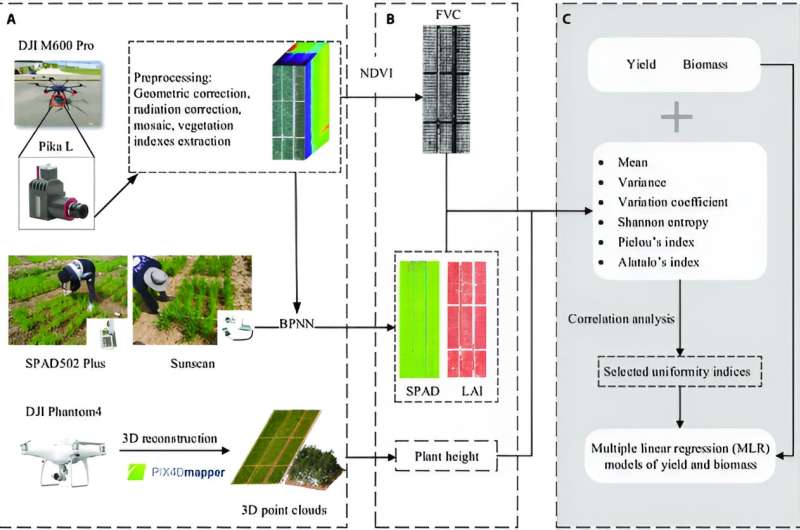This article has been reviewed according to Science X's editorial process and policies. Editors have highlighted the following attributes while ensuring the content's credibility:
fact-checked
trusted source
proofread
New UAV-based method enhances wheat uniformity monitoring and yield prediction

A research team has developed an innovative method to quantify wheat uniformity using unmanned aerial vehicle (UAV) imaging technology. This method estimates leaf area index (LAI), SPAD, fractional vegetation cover, and plant height, calculating 20 uniformity indices throughout the growing season.
Pielou's index of LAI showed the strongest correlation with yield and biomass. This approach enables effective monitoring of wheat uniformity, offering new insights for yield and biomass prediction, and has potential applications in crop management and future wheat breeding programs.
Wheat is a crucial global crop, but current population growth, extreme weather, and climate change have increased demands on wheat production. Uniform population structure is key for high yields, but uneven field conditions lead to competition among plants, preventing uniformity.
Traditional methods for measuring uniformity are labor-intensive and inefficient. Current research focuses on spatial uniformity of individual plants and lacks multi-trait assessments across growth stages.
A study published in Plant Phenomics on 18 Jun 2024, aims to develop a comprehensive method for assessing wheat uniformity throughout its growth stages, using UAV-based phenotyping to evaluate its impact on yield and biomass.
This research utilized UAV-based imaging technology to estimate wheat agronomic parameters: SPAD, LAI, and plant height (PH). The BPNN model demonstrated high accuracy for LAI (R2=0.889) and SPAD (R2=0.804), and the PH estimation from 3D point clouds also showed strong accuracy (R2=0.812). These accurate estimations provided a foundation for calculating uniformity indices.
The study revealed that uniformity indices for LAI, SPAD, FVC, and PH varied dynamically across growth stages, with indices generally stabilizing after heading. Furthermore, correlation analyses uncovered strong correlations between specific indices, such as LJ for LAI, and yield (r=-0.760) and biomass (r=-0.801).
Multiple linear regression models that incorporated these uniformity indices outperformed models based on mean values, resulting in improved accuracy for yield (R2=0.616) and biomass (R2=0.798) predictions. This method effectively monitors wheat uniformity and provides insights for enhancing crop yield and biomass estimation.
According to the study's senior researcher, Dong Jiang, "The proposed uniformity monitoring method can be used to effectively evaluate the temporal and spatial variations in wheat uniformity and can provide new insights into the prediction of yield and biomass."
In summary, this study developed a UAV-based method to monitor wheat uniformity. Models using uniformity indices demonstrated higher accuracy than those using mean values, offering valuable insights for yield and biomass prediction. Looking ahead, different uniformity indices can improve crop management and breeding.
Future research should explore the relationship between uniformity and productivity across growth stages and validate this method for other crops to enhance agricultural practices.
More information: Yandong Yang et al, UAV-Assisted Dynamic Monitoring of Wheat Uniformity toward Yield and Biomass Estimation, Plant Phenomics (2024). DOI: 10.34133/plantphenomics.0191
Provided by NanJing Agricultural University




















